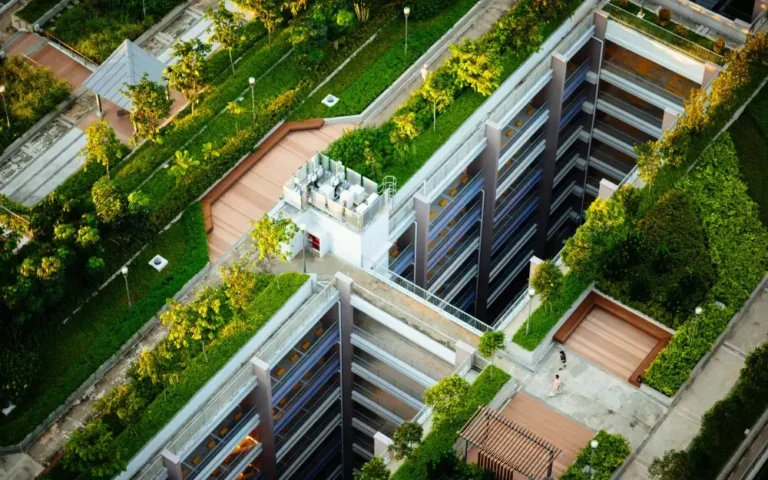Green roofing systems, often called living roofs, have gained significant traction recently due to their numerous environmental and energy-saving benefits. By integrating vegetation and soil into building structures, these roofs provide an effective means of improving energy efficiency. They are not merely an aesthetic enhancement but play a critical role in reducing energy consumption and enhancing overall building performance. We will explore how green roofing systems contribute to energy efficiency through improved insulation, reduced heat island effect, and enhanced stormwater management.
Improved Insulation and Temperature Regulation
One of the most significant contributions of green roofing to energy efficiency is its ability to enhance insulation properties. Traditional roofing materials often absorb heat, leading to higher temperatures inside buildings during warmer months. In contrast, green roofs help to regulate internal temperatures by providing an additional layer of insulation. The soil and vegetation on a green roof absorb and dissipate heat, which helps to keep the building cooler during hot weather. This natural cooling effect can significantly reduce the need for air conditioning, leading to lower energy consumption and reduced utility costs.
Moreover, green roofs can serve as insulation in colder climates, preventing heat loss during winter months. The layers of soil and plants trap heat and provide a buffer against cold air, resulting in a more energy-efficient building. This thermal performance translates into less reliance on heating systems, decreasing energy demand and lowering greenhouse gas emissions associated with fossil fuel-based heating. By improving insulation and temperature regulation, green roofing enhances comfort for occupants and contributes to significant energy savings over time.
Mitigating the Urban Heat Island Effect
Green roofs also play a crucial role in mitigating the urban heat island (UHI) effect, where urban areas experience significantly higher temperatures than their rural surroundings. This effect is primarily caused by the extensive use of concrete, asphalt, and other materials that absorb and retain heat. Green roofs help counteract this by providing vegetation that cools the surrounding air through evapotranspiration. As plants release moisture, the air becomes cooler, lowering local temperatures and improving overall air quality.
By reducing the urban heat island effect, green roofs contribute to energy efficiency for individual buildings and entire neighborhoods and cities. Lower ambient temperatures can reduce energy consumption for cooling, leading to less strain on electrical grids during peak usage. Additionally, by minimizing heat absorption, green roofs can contribute to the longevity of traditional roofing materials, reducing the frequency and costs associated with roof replacement. Ultimately, the environmental benefits of green roofs extend beyond individual buildings, creating healthier urban ecosystems that promote energy efficiency and sustainability.
Enhanced Stormwater Management
Another significant aspect of green roofing systems is their ability to manage stormwater effectively. Traditional roofs often increase runoff, potentially flooding and contaminating local water bodies. Green roofs help to absorb rainwater, reducing runoff and alleviating the burden on urban drainage systems. The soil and vegetation retain moisture, allowing for gradual release into the atmosphere through evapotranspiration. This process mitigates flooding and improves water quality by filtering pollutants.
By managing stormwater effectively, green roofs contribute to energy efficiency in several ways. First, they reduce the need for extensive stormwater management infrastructure, often requiring energy-intensive pumping and treatment processes. Second, effective stormwater management minimizes the risk of water damage to buildings, thereby reducing repair costs and extending the life of the building. This translates to lower energy demands related to repairs and replacements. Thus, through efficient stormwater management, green roofs provide a multifaceted approach to promoting energy efficiency in urban environments.
Increased Property Value and Market Appeal
Incorporating green roofing can enhance property values and market appeal. As sustainability becomes an increasingly important factor for homebuyers and renters, buildings with green roofs can stand out in the competitive real estate market. Properties featuring green roofs often attract environmentally conscious individuals who value energy efficiency and sustainability. This heightened demand can increase rental prices or property values, providing property owners with a compelling return on investment.
Furthermore, green roofs can reduce operating costs through energy savings, translating to improved profitability for commercial properties. Businesses that invest in green roofs can benefit from lower utility bills, tax incentives, and potential grants for sustainable practices. As energy efficiency becomes a priority for building regulations, incorporating green roofs can ensure compliance with evolving standards, safeguarding property value against future regulatory changes. By boosting property value and market appeal, green roofs are a strategic investment for owners while promoting energy efficiency.
Implementing green roofing systems through our Wellesley office offers significant advantages in promoting energy efficiency across urban landscapes. Through improved insulation and temperature regulation, green roofs reduce energy consumption for heating and cooling. They mitigate the urban heat island effect, contributing to cooler neighborhoods and lower energy demand. Furthermore, enhanced stormwater management prevents flooding and minimizes energy-intensive water treatment processes. Finally, the increased property value and market appeal of buildings with green roofs create compelling reasons for property owners to invest in this sustainable practice. Green roofing systems present a holistic approach to achieving energy efficiency while fostering environmental sustainability in urban areas.
